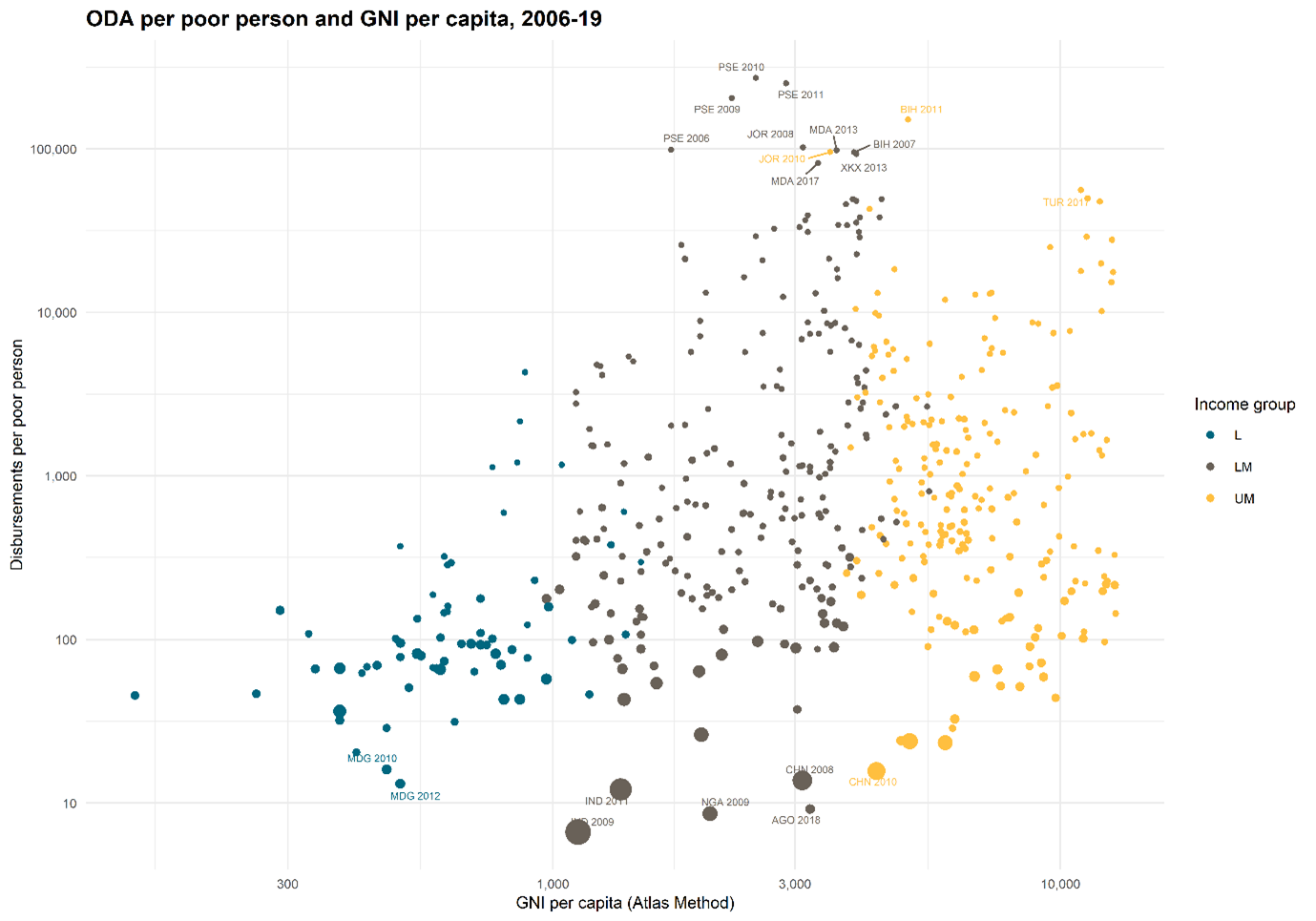Recommended
In the UK’s newly released international development strategy, the government commits to upping bilateral finance to 75 percent of the Foreign Commonwealth & Development Offices (FCDO)’s total aid spend by 2025. Here, we look at what this means for budgets, and for the UK’s international role.
While this can be achieved—by replacing post-Brexit falls in contributions to the EU with bilateral support—this commitment seems an unhelpful constraint. We look here at the implications of this commitment, alongside FCDO staff reductions, and a potential return to spending 0.7 percent of GNI on aid, and conclude that we’d prefer to see the UK pursuing its ideals through the multilateral system, rather than around it.
Comparing multilateral and bilateral effectiveness
The best multilaterals are a highly effective way to spend your aid budget—the top five slots in our Quality of Official Development Assistance (ODA) Assessment are all taken by multilaterals—they get finance to countries where it’s most-needed; achieve ownership by recipients; evaluate their programmes effectively; and are transparent in their work. Many score above the UK’s bilateral spend (which ranks 16th). Still, bilateral support can be important, not least politically, potentially in line with Stefan Dercon’s argument to ‘gamble’ on supporting countries whose elites have accepted a development bargain (though as colleagues recently pointed out, only a tiny fraction of the UK’s bilateral support actually goes to partner governments).
Over the last decade, the UK has provided an average of 37 percent of its aid budget to multilateral institutions—putting it in the middle of its G7 peers. The below table shows how this could change going forward based on March projections from the Office for Budget Responsibility for GNI.
UK ODA and multilateral spend and projections—(nominal GBP billions)
|
|
2016 |
2021 |
2025 |
|
|
ODA |
ODA |
|||
|
ODA |
13.4 |
11.5 |
13.8 |
19.3 |
|
Bilateral |
8.5 |
7.1 |
10.4 |
14.5 |
|
Multilateral |
4.8 |
4.4 |
3.5 |
4.8 |
|
- of which: EU |
1.5 |
1.5 |
0.3 |
0.3 |
|
- of which: Multilateral (excl. EU) |
3.3 |
2.9 |
3.1 |
4.5 |
Source: Authors’ calculations; UK Statistics on International Development; OBR (March 2022) projections. The data for this table and other years is available here.
Note: The commitment to spend 75 percent bilaterally is only for FCDO budgets, but as FCDO’s total ODA spend is not available, we’ve applied the commitment to the entire ODA budget (FCDO accounts for the vast majority of multilateral spend).
Scheduled reductions in UK contributions to the EU budget as part of the withdrawal agreement will account for a large reduction in multilateral spending. These averaged 11 percent of total ODA over the past decade. Future contributions will depend on actual EU spend but estimates based on officials’ expectations imply this will decline from £1.5bn last year to under £100m in 2029.
If the UK ODA budget remains at 0.5 percent and the economy grows as the OBR expects, then the UK multilateral budget, after EU contributions, will actually grow in nominal terms to £3.1bn in 2025. Still, with cumulative inflation to 2021 likely to exceed 10 percent (again based on OBR projections of the GDP deflator) this marks a real-terms decline, and the UK would likely be providing smaller contributions to replenishments than its peers. Of course, this takes for granted the lost influence at EU institutions, who are the world’s third largest aid provider.
Will the aid budget return to 0.7 percent of GNI?
If the Government does return to spending 0.7 percent of GNI as ODA by 2025 and spends 25 percent on multilaterals, its non-EU multilateral contributions will see a rise in nominal and real terms, to £4.5bn (or £4.1bn at 2021 prices)— but still below the levels seen in the mid-2010s.
The Chancellor’s tests for whether he returns aid to 0.7 percent depend mainly on his own fiscal plans, but the potentially weaker state of the economy, and a need to spend to alleviate cost of living issues has made an imminent return less likely.
If the Government does return to the target in 2024 as the spending review envisioned, it would involve a major step-up in spend of at least £4.5bn. Colleagues have highlighted how unprepared the Government is for such a return and so using multilaterals ability to deal with large sums would surely make sense to ensure the increase is well-spent.
Upcoming replenishments
In the period to 2025, there are scheduled replenishments for the Global Environment Fund (funding from Q3 2022); the African Development Fund and the Global Fund (both from Q1 2023); and the Green Climate Fund (from Q1 2024). The UK would have to set aside almost £1.1bn in 2025 to maintain its current annual (nominal) funding to each of these organisations (£63m for GEF, £207m for AfDF, £467m for the Global Fund, and £360m for GCF).
Falling EU contributions and cuts made to the World Bank IDA replenishment could enable the UK to maintain its contributions to other multilaterals at their current levels. The UK has already reduced its contribution to the World Bank’s IDA from an annual average of £1.2bn over 2011-2020 to an expected £471m by 2024. In 2025 then, after commitments to the EU (and if IDA continues at that lower level) the remaining multilateral budget would be nearly £2.7bn, which would be enough to maintain nominal commitments to all other multilaterals in prior years (e.g. these were £2.5bn in 2020 and 2021). It would also, though, need to accommodate any contributions to the IMF for SDRs.
What about bilateral?
The UK’s bilateral budget meanwhile, is planned to increase to at least to £10.3bn in 2025, and potentially £14.5bn (if there were a return to 0.7). The latter figure would be more than double the 2021 figure of £7.1bn, and both scenarios would see spend above the 2020 figure of £9.5bn.
A major challenge for the increase in the bilateral budget would appear to be the staff resources needed to manage it well. As part of the creation of the FCDO, it was expected to shed 10 percent of its staff costs (it had 10,331 full-time equivalent posts at its inception), and the Prime Minister recently announced new cuts to civil service to 2025 of more than 90,000, 20 percent of the total. Many civil service roles are public-facing, for example in justice, tax, and pensions—so FCDO may be asked to take a higher proportion of the cuts. But even at 20 percent, it would need to cut nearly 2,000 further jobs (out of 9,565 full-time equivalents). The Development strategy contains plans to reduce bureaucracy but with a potentially steeply increasing bilateral budget this may lead to real political and value for money risks from hastily chosen projects.
Key takeaways
The ceiling on multilateral contributions announced in the development strategy will mainly be achieved by the UK reallocating its EU contributions to its bilateral budget. As well as its departure from the EU, the UK has also significantly reduced its contribution to the World Bank’s IDA replenishment, and these reductions will enable its bilateral budget to return to the absolute levels seen before the cut to 0.5 percent.
Given multilaterals’ generally strong performance, and planned big rises in bilateral spend against a backdrop of falling staff numbers, the new commitment to bilateral spending may create the circumstances for poorly-spent aid.
The cap on multilateral contributions is an unnecessary and unhelpful restriction. We think the Foreign Secretary should continue to spend substantially through multilaterals and work through them to promote the UK's values and support sustainable, long-term progress.
The calculations supporting the summary in this blog can be found here.
Disclaimer
CGD blog posts reflect the views of the authors, drawing on prior research and experience in their areas of expertise. CGD is a nonpartisan, independent organization and does not take institutional positions.






